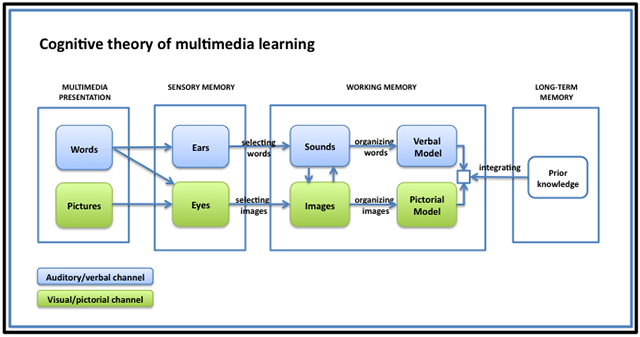This is an old revision of the document!
General
Cognitive theory of multimedia learning is one of the cognitivist learning theories introduced by an American psychology professor Richard Mayer in the 1990s. This theory is a sub-theory of John Sweller's cognitive load theory applied especially for multimedia learning, and therefore has many similarities with it. Basic assumption of Mayer's theory is that the human working memory has two sub-components that work in parallel (visual and verbal/acoustic) and that learning can be more successful if both of this channels are used for information processing at the same time.
Mayer's theory is based on three assumptions suggested by cognitive research1)2):

Dual-channel assumption - The verbal and visual channels (similar to what Baddeley called
phonological loop system and
visuospatial sketchpad3)) in our working memory are separated and can be used for processing information simultaneously thus enhancing process of learning. The suggestion that human working memory has more sub-components firstly came from the working memory models designed by
Alan Baddeley and
Graham Hitch in 1974
4) and reviewed by Baddeley in 1992
5). These findings where further incorporated to the
Dual coding theory by
Allan Paivio6) and later by Mayer and his colleagues.
Limited capacity assumption - As Miller's
Information processing theory has shown, these channels have limited capacity
7) and limited time
8) they can hold information. Too much information can therefore cause
cognitive overload.
9)
Active-processing assumption - Learning is an active process of collecting, organizing and integrating new information
10). Similarities with
constructivist learning may be noticed in this definition.
Together with cognitive load theory, which offers a more detailed description of cognitive load types and possible causes of cognitive overload, the mentioned assumptions of cognitive theory of multimedia learning form a framework and theoretical basis for most contemporary research on learning. This research is mostly oriented on two goals:
utilizing both information processing channels, and
managing cognitive load and avoiding cognitive overload.
Research results have revealed a number of so called principles and effects describing different phenomena related to learning, instructional aids and ways of reducing cognitive load.
As mentioned, research in frames of cognitive theory of multimedia learning and cognitive load theory has revealed a number of principles and effects introduced by Sweller11), Mayer12), and a number of other researchers. Simplified, these principles and effects suggest that students learn better:
from words and pictures than from words alone,
from animation and narration together than only from animation or narration or on-screen text,
when corresponding words and pictures are presented close rather than far from each other on the page or screen,
when corresponding words and pictures are presented simultaneously rather than one after another,
when extraneous interesting but irrelevant material is excluded rather than included,
when important information in the learning material is marked or emphasized,
animation or text are broken down into smaller segments,
when they are presented with worked examples before they try to solve a problem on their own,
when they are prompted to self-explain a step in a procedure,
when they study complex material in collaboration with other students,
when their prior knowledge is activated prior to learning new material, and
when they receive amount of guidance depending on their expertise level.
All of this design effects are stronger for low-knowledge learners than for high knowledge learners, and for high-spatial learners rather than for low-spatial learners.
Criticisms
Cognitive theory of multimedia learning is mostly subjected to same criticisms as the cognitive load theory since it is an extension of it.
Keywords and most important names
Cognitive theory of multimedia learning, dual coding theory, visual and verbal/acoustic channel, modality principle, redundancy principle, spatial contiguity principle, temporal contiguity principle, coherence principle, individual differences principle
-
Bibliography
Read more